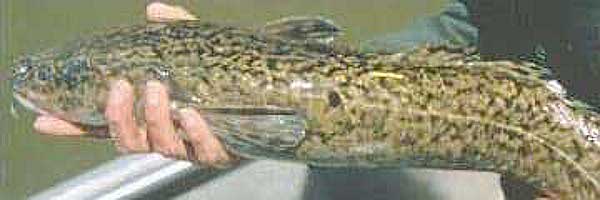Tribe working to bring back burbot
|
|
January 4, 2013 |
 |
The odds are long, but Kootenai Tribe of Idaho
biologists and others are hoping this year to
witness a rebirth of burbot reproductive
activity in north Idaho’s Kootenai
River-reservoir-tributary system.
The tribe is spearheading an effort to revive a
native burbot – freshwater cod – population that
as recently as 2003 was estimated to include
fewer than 50 wild burbot spawners.
Finding an adult spawner has been probably
harder than finding a needle in the proverbial
haystack.
The number of burbot encountered during Idaho
Department of Fish and Game wintertime surveys
“got progressively worse until we started
putting in hatchery fish,” said Shawn Young, a
fishery biologist and researcher with the
tribe’s Fish and Wildlife Department. That
experimental aquaculture program began in 2003
in collaboration with the University of Idaho.
The research program at the UI has fed small,
though increasing, numbers of hatchery produced
fish for release into the system since 2009. Now
some of the surviving members from that 2009
release – 36 or so based on year-to-year
survival estimates – should have advanced to 100
percent sexually maturity.
“They should be looking for some spawning
partners,” Young said of the survivors.
Known spawning areas will be monitored for the
presence of fish. Those tributaries are where
releases were focused. Biologists will also
check out “candidate” areas where there is
coarse, gravel substrate that burbot seem to
prefer.
Through the years the hatchery releases have
been equipped with PIT-tags and in the case of
some larger fish, acoustic tags that can be
detected by receivers. Much of the trapping,
tagging and monitoring is carried out by the
Idaho Department of Fish and Game.
Burbot are known to come together and form
“spawning balls with dozens of fish in each
congregation,” Young said. Eggs dropped by
females are fertilized in the water column by
sperm from the males. The fertilized eggs then
drop where they may.
Young and other biologists have witnessed the
phenomenon (with the help of an underwater
camera) at British Columbia’s Moyie Lake. The
lake, just north of the Idaho-Montana border at
the head of the Moyie River, has a healthy
burbot population and has been the source of
broodstock for the experimental hatchery
program. The Moyie River flows out of the lake
and empties into the Kootenai River.
Spawning is expected in February.
Spawning-time monitoring will be looking for
such aggregations of fish. On average eggs hatch
out about 50 days after the spawning event, but
timing depends on the water temperature.
“They spawn in the coldest part of the year,”
Young said, often under ice with river
temperatures barely above freezing at 1-2
degrees C.
The 2009 releases included 179 1-year-olds, 23
2-year-olds and seven 3-year-olds. Burbot have
been known to reproduce as early as at age 2,
but for the vast majority 4 and older is the
primary reproductive age.
From 2009-2012 at total of 1,670 1 to
3-plus-year-old sub-adults have been released,
including 653 1-year-olds last year. They have
been shown to survive through their first year
in the wild at a rate of up to 50 percent.
Another 39,000 burbot have been released as six
month old juveniles, including 16,000 in 2012.
They are estimated to have a first-year survival
rate of about 25 percent.
“That’s the life stage we’re targeting” for the
bulk of the releases, Young said. The
6-month-old fish can be grown in greater
numbers, and with less hatchery space for each
fish, than the older fish.
Additionally, 314,000 burbot larvae hatched out
at the UI have been released, including 265,000
in 2012.
“We have no idea what kind of survival we’re
talking about” with the larvae, though it is
almost certain to be much lower than for the
older releases, Young said.
“Almost all of them went into Kootenay Lake,”
Young said. The lake is generally warmer than
the river or its tributaries, and has a better
early season supply of zooplankton, which need
to begin feeding about 10 days after they hatch
out.
Biologist have seen dispersal of the released
hatchery burbot throughout system, which
stretches approximately 150 miles from the
Kootenai-Moyie confluence on the east side of
the Idaho panhandle downstream to the upper end
of the Lardeau River Delta in the North Arm of
Kootenay Lake. The mean dispersal of all
released burbot was 50.5 km (31 miles).
The project is being carried out in
collaboration with the British Columbia Ministry
of the Environment, IDFG, U.S. Fish and Wildlife
Service and the UI’s Aquaculture Research
Institute.
Basic culture methods have now been established
and documented for spawning, egg incubation,
larval rearing and juvenile grow out. Hatching
and rearing techniques have been honed by UI
researchers to the point that larvae are being
produced in relatively large numbers.
Among the goals of the Kootenai Tribe’s program,
which is largely funded by the Bonneville Power
Administration, is to implement a plan to
reverse the population decline through habitat
restoration, and research to identify and
address gaps in understanding of the specific
causes of decline of populations of species such
as the burbot and white sturgeon.
The tribe’s conservation aquaculture program for
white sturgeon is being implemented to reverse
population declines and rebuild a population
with demographic and genetic characteristics to
ultimately become sustainable and resilient. A
new hatchery has been proposed to both expand
white sturgeon production, and begin burbot
culturing on a larger scale than be done at the
UI laboratory.
|
|
Questions or comments about this
article?
Click here to e-mail! |
|
|
|
|

